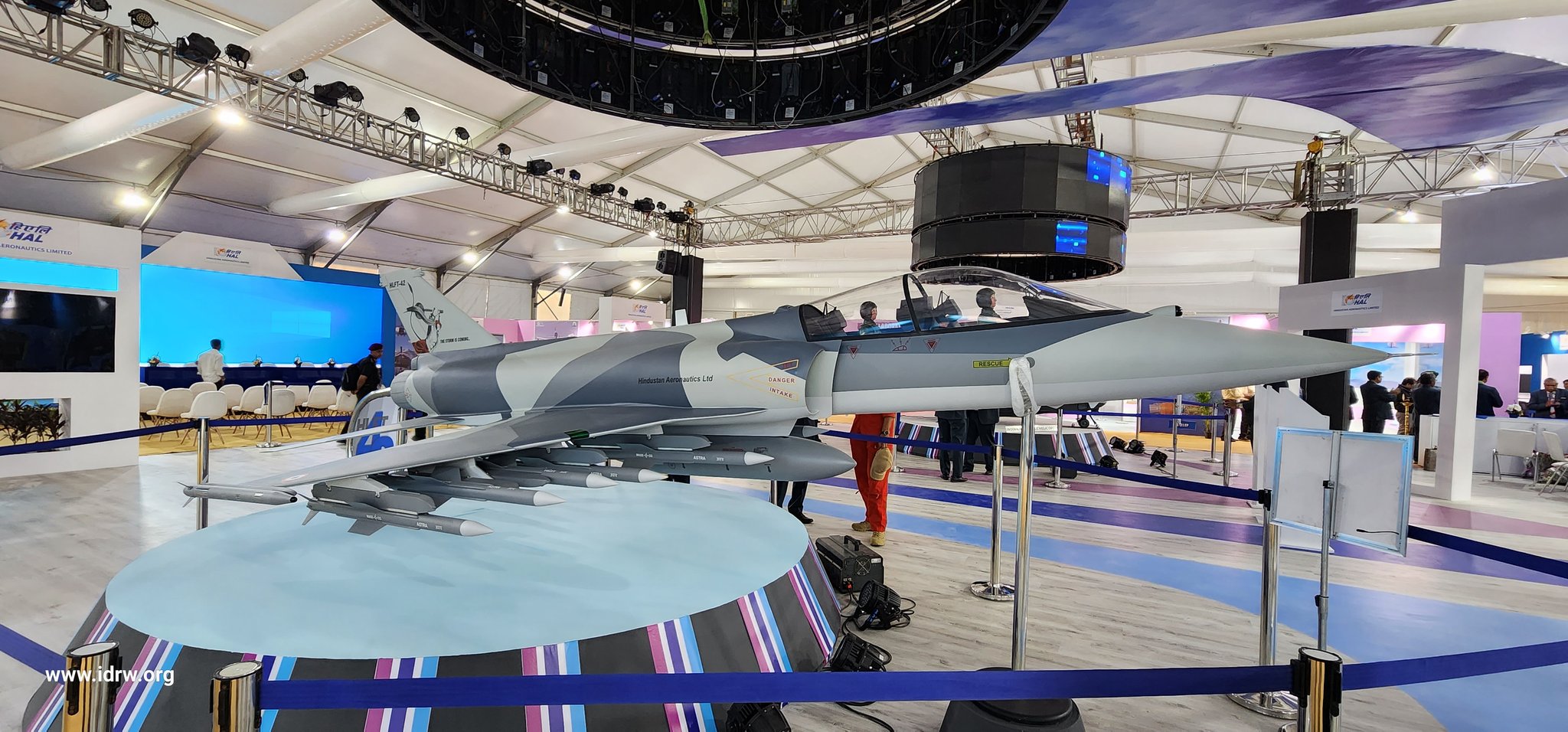SOURCE: RAUNAK KUNDE / NEWS BEAT / IDRW.ORG


Hindustan Aeronautics Limited (HAL) has officially kicked off the search for a suitable engine to power its ambitious Hindustan Lead-in Fighter Trainer (HLFT-42), a next-generation supersonic trainer designed to prepare pilots for India’s advanced combat aircraft. On March 17, 2025, HAL issued a Request for Information (RFI) to global engine vendors, specifying a thrust requirement of 95-100 kilonewtons (kN) and a total technical life of 6,000 hours.
As the hunt intensifies, the General Electric F414 emerges as the frontrunner, but whispers of HAL’s under-development 110kN engine for the Advanced Medium Combat Aircraft (AMCA) suggest a potential shift toward engine commonality—a move that could redefine the HLFT-42’s role in training future AMCA pilots.
Unveiled as a scale model at Aero India 2023, the HLFT-42 is envisioned as a bridge between basic trainers and India’s frontline fighters, such as the Tejas Mk2 and the AMCA. With a maximum takeoff weight (MTOW) of 16.5 tons and a design that supports a Mach 1.8 top speed and operations up to 60,000 feet, this supersonic trainer is no ordinary platform. It’s equipped with advanced avionics—Active Electronically Scanned Array (AESA) radar, Infrared Search and Track (IRST), and Fly-by-Wire (FBW) systems—making it a high-end simulator for 4.5- and 5th-generation fighter jets. Beyond training, its 4.5-ton payload capacity and 11 hardpoints hint at a secondary combat role, positioning it as a versatile asset for the Indian Air Force (IAF).
The RFI’s thrust specification of 95-100 kN reflects the HLFT-42’s need for robust power to meet these demands. Unlike traditional trainers, which prioritise stability and fuel efficiency, the HLFT-42 requires an engine capable of delivering high performance for combat-like manoeuvres while ensuring trainee safety and reliability. This balance has set the stage for a critical decision in engine selection.
The General Electric F414, with its proven track record and a maximum thrust of 98 kN, aligns closely with HAL’s requirements. Already selected for the Tejas Mk2, the F414 offers familiarity, an established supply chain, and a thrust profile that fits the HLFT-42’s 95-100 kN window. Its use in aircraft like the F/A-18E/F Super Hornet and South Korea’s KF-21 Boramae underscores its reliability for high-performance roles. For HAL, choosing the F414 could streamline logistics and training, leveraging India’s existing infrastructure for the engine, including plans for local production under a June 2023 deal with GE Aerospace.
However, the F414’s selection isn’t without caveats. While it meets the thrust threshold, some speculate it may fall short of providing the extra power needed for the HLFT-42’s ambitious training envelope, particularly for simulating the AMCA’s supercruise and high-altitude dynamics. Additionally, the lack of full intellectual property rights (IPR) transfer in the Tejas deal, as confirmed by HAL in May 2024, limits India’s ability to modify or innovate on the engine independently, a concern that could resurface with the HLFT-42.
Enter the 110kN engine, currently to be developed by India’s Gas Turbine Research Establishment (GTRE) in collaboration with a foreign partner (likely Safran or Rolls-Royce) for the AMCA program. Designed to power India’s 5th-generation stealth fighter, this engine promises a dry thrust of 75 kN and a wet thrust exceeding 110 kN, tailored for supercruise and operation in India’s hot and humid conditions. Though still years from maturity—projected for the mid-2030s—this powerplant offers a tantalizing possibility for the HLFT-42: engine commonality with the AMCA.
The AMCA, unlike most modern fighters, won’t have a dedicated twin-seat trainer variant due to its stealth-focused design and cost constraints. Instead, the IAF plans to rely on advanced simulators and lead-in trainers like the HLFT-42 to prepare pilots. Pairing the HLFT-42 with the AMCA’s 110kN engine could ensure near-identical flight dynamics, giving trainees a realistic feel for the AMCA’s performance envelope—crucial for mastering its supercruise, stealth, and sensor fusion capabilities. This commonality would also simplify maintenance, spares, and logistics across both platforms, a strategic advantage for a fleet expected to serve into the 2060s.
Trainer aircraft often demand more thrust than their combat counterparts to accommodate dual roles: safe, low-speed handling for novices and high-performance simulation for advanced training. The HLFT-42’s mission to mimic 5th-generation fighters amplifies this need. A 110kN engine could provide the extra margin to replicate AMCA-specific scenarios—such as sustained supersonic flight without afterburners, while offering headroom for future upgrades, like manned-unmanned teaming with the CATS Warrior drone.
Opting for the 110kN engine comes with risks. Its development timeline lags behind the HLFT-42’s, potentially delaying the trainer’s rollout past the early 2030s. The F414, conversely, is available now, enabling HAL to fast-track a prototype using internal funds and Tejas components, as planned. Cost is another factor—the AMCA engine’s advanced features could inflate expenses, whereas the F414’s established production keeps it competitive.
NOTE: Article cannot be reproduced without written permission of idrw.org in any form even for YouTube Videos to avoid Copy right strikes. Websites doing illegal reproductions will get DMCA and Legal Notices.